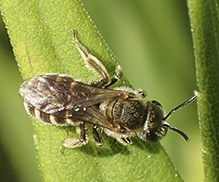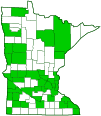confusing furrow bee
(Halictus confusus)
Conservation • Description • Habitat • Ecology • Distribution • Taxonomy
Conservation Status |
|
|||||||
| IUCN Red List | not listed |
|||||||
| NatureServe | NNR - Unranked SNR - Unranked |
|||||||
| Minnesota | not listed |
|||||||
Description |
||
Confusing furrow bee is a common, small, ground-nesting bee. It occurs in Europe, Asia, and North America. It occurs throughout the United States and southern Canada but is mostly absent from the southernmost tier of states and from the Great Plains. It is a generalist feeder and visits a very wide variety of flowers. The female is ¼″ (7 mm) in length. The head is slightly wider than long. It is dull greenish with metallic reflections, and it is deeply and distinctly pitted (punctate). The antennae have 12 segments, a long scape at the base, a short pedicel, and a whip-like section (flagellum) with 10 segments (flagellomeres). On the face there is just a single line-like groove extending downward from the base of each antenna (subantennal suture). The plate on the face (clypeus) is more blackish and is distinctly bulging. There are two large compound eyes on the sides of the head and three simple eyes (ocelli) in a triangle on top of the head. The compound eyes slightly converge toward the bottom. The cheeks (genae) are slightly wider than the compound eyes. The tongue is short. The thorax is colored like the head, dull greenish with metallic reflections. The punctures on the upperside are fine and close but not crowded. The small plates (tegulae) covering the wing bases are yellowish in front, becoming more reddish-brown in back. The abdomen is blackish with metallic greenish reflections, and it is finely and closely punctate. Each abdominal segment has a band of whitish hairs at the end. This feature distinguishes the genus Halictus from the closely related genus Lasioglossum, which has bands at the front. The legs are mostly blackish, becoming reddish-brown near the end. The wings are mostly translucent with yellowish veins and a yellowish cell (stigma) on the leading edge (costal margin) just before the marginal cell. The marginal cell is pointed but not sharply pointed. There are three submarginal cells. The first cell is as long as the second and third cells combined. The veins dividing the submarginal cells are dark and prominent. The basal vein is strongly arced at the base, like the letter J. The male is about the same size as the female. The head is slightly longer than wide. The antennae have 13 segments. The first flagellomere is yellow on the underside and is short, only half as long as the second flagellomere. The lower third of the clypeus is yellow. The wing veins are brick red. The third segment (femur) of each leg is brick red. The fourth segment (tibia) is brick red but has a yellow longitudinal stripe on the upper (outer) side. The last part of the leg (tarsus), corresponding to the foot, is yellowish. |
||
Size |
||
Female: ¼″ (7 mm) Male: ¼″ (7 mm) |
||
Similar Species |
||
Habitat |
||
|
||
Ecology |
||
Season |
||
Several overlapping generations per year: early spring to autumn |
||
Behavior |
||
Sometimes large numbers build their nests close together. |
||
Life Cycle |
||
|
||
Larva Food |
||
Flower pollen |
||
Adult Food |
||
Flower nectar and pollen |
||
Distribution |
||||
|
Sources |
|||
| 6/15/2023 | ||||
Occurrence |
||||
Common |
||||
Taxonomy |
|||
Order |
Hymenoptera (Ants, Bees, Wasps, and Sawflies) | ||
Suborder |
Apocrita (Narrow-waisted Wasps, Ants, and Bees) | ||
Infraorder |
Aculeata (Ants, Bees, and Stinging Wasps) | ||
Superfamily |
Apoidea (Bees and Apoid Wasps) | ||
| Epifamily | Anthophila (bees) | ||
Family |
Halictidae (sweat bees) | ||
Subfamily |
Halictinae (sweat and furrow bees) | ||
Tribe |
Halictini | ||
Genus |
Halictus (furrow bees) | ||
| Subgenus | Seladonia | ||
Subordinate Taxa |
|||
confusing furrow bee (Halictus confusus alpinus) Arapaho metallic-furrow bee (Halictus confusus arapahonum) confusing furrow bee (Halictus confusus confusus) confusing furrow bee (Halictus confusus perkinsi) |
|||
Synonyms |
|||
Halictus alpinus Halictus arapahonum Halictus constrictus Halictus flavipes Halictus nearcticus Halictus olivarius Halictus perkinsi Halictus provancheri Seladonia confusa |
|||
Common Names |
|||
confusing furrow bee confused sweat bee |
|||
Glossary
Clypeus
On insects, a hardened plate on the face above the upper lip (labrum).
Femur
On insects and arachnids, the third, largest, most robust segment of the leg, coming immediately before the tibia. On humans, the thigh bone.
Flagellomere
A segment of the whip-like third section of an insect antenna (flagellum).
Gena
In insects: The area between the compound eye and the mandible; the cheek. In birds: The area between the the angle of the jaw and the bill; the feathered side (outside) of the under mandible. Plural: genae.
Ocellus
Simple eye; an eye with a single lens. Plural: ocelli.
Punctate
Dotted with pits (punctures), translucent sunken glands, or colored spots of pigment.
Stigma
In plants, the portion of the female part of the flower that is receptive to pollen. In Lepidoptera, an area of specialized scent scales on the forewing of some skippers, hairstreaks, and moths. In other insects, a thickened, dark, or opaque cell on the leading edge of the wing.
Tegula
A small, hardened, plate, scale, or flap-like structure that overlaps the base of the forewing of insects in the orders Lepidoptera, Hymenoptera, Diptera, and Homoptera. Plural: tegulae.
Tarsus
On insects, the last two to five subdivisions of the leg, attached to the tibia; the foot. On spiders, the last segment of the leg. Plural: tarsi.
Tibia
The fourth segment of an insect leg, after the femur and before the tarsus (foot). The fifth segment of a spider leg or palp.
Visitor Photos |
|||||
Share your photo of this insect. |
|||||
| This button not working for you? Simply email us at info@MinnesotaSeasons.com. Attach one or more photos and, if you like, a caption. |
|||||
Babette Kis |
|||||
Halictus confusus confusing furrow bee Halictus confusus, confusing furrow bee, on a goldenrod leaf. Picture was taken on Barnes Prairie, Racine Co., Wisconsin on July 8, 2021. |
 |
||||
MinnesotaSeasons.com Photos |
|||||
|
|||||

Visitor Videos |
|||
Share your video of this insect. |
|||
| This button not working for you? Simply email us at info@MinnesotaSeasons.com. Attach a video, a YouTube link, or a cloud storage link. |
|||
Other Videos |
|||
| Halictus confusus CONFUSING METALLIC FURROW BEE digging burrow 3026169 ob Curtis |
|||
About
Oct 9, 2021 Halictus confusus CONFUSING METALLIC FURROW BEE digging burrow. |
|||
| Halictus (Seladonia) confusus ♂ (Halicidae-Hymenoptera) 2017 flhorea01 |
|||
About
Dec 5, 2017 Halictus (Seladonia) confusus petit halicte mâle ou ici je pense que c'est bien lui. Je vois plus souvent des femelles, cette fois les deux se trouvaient ensemble. Les femelles sont plus difficiles à différencier à l'oeil nu. |
|||


Created: 6/15/2023
Last Updated:



